Ectomycorrhizal Fungi Promote Cultivation of Camellia Plants
Tang Yongjun, Zhou Ming*
Xin-Lü Camellia Nursery Co. Ltd. of the World’s Best Cultivars, Chuxiong City
* author for correspondence, e-mail: ZZMM168@163.COM
Introduction
Mycorrhizae are widespread symbioses formed by a group of soil fungi (known as mycorrhizal fungi) with plants. Recently, mycorrhizal fungi have been found to influence plant distribution and plant community structure. They may also affect interactions between plant species. Furthermore, their effects on other ecological processes in their ecosystems have been suggested. In most cases, mycorrhizal fungi have beneficial effects on host plants, physiologically or ecologically promoting performance of their associated hosts. As a result, productivity and biomass of their hosts are increased and resistance of the hosts to stressed environment is often enhanced. Mycorrhizal fungi stimulate growth of their host plants in several ways, including increasing absorption area of host roots with fine hyphae, producing plant enzymes for activation of otherwise inaccessible nutrients, or secreting antibiotics against plant pathogens. Based on their colonization sites, mycorrhizal fungi are grouped into two groups, ectomycorrhizal fungi and endomycorrhizal fungi. Ectomycorrhizal fungi are often associated with tree species and have significant growth stimulation effects on their hosts.
In recent years, ectomycorrhizal fungi have been used in forest restoration, which proved successful in some cases. However, to our knowledge, investigation on Camellia species from a mycorrhizal perspective has been rare and no studies have been done regarding application of mycorrhizal fungi to Camellia cultivation. In this paper, we report a case study of application of ectomycorrhizal fungi to cultivation of Camellia cultivars. We isolated and identified mycorrhizal fungi from natural habitats of Camellia and propagated the fungi as inocula for cultivation of Camellia cultivars. The mycorrhizal inocula have been widely used in our company for cultivation of Camellia cultivars and have shown significant promoting effects on performance of the plants. The successful isolation and application of ectomycorrhizal fungi are of great importance for production of high quality cultivation medium as well as commercial seedlings of Camellia cultivars.
Materials and Methods
Isolation and identification of ectomycorrhizal fungi
Camellia rootlets from their natural habitats were used for isolation of ectomycorrhizal fungi. The rootlets were surface sterilized using sodium hypochlorite (NaOCl) or mercuric chloride (HgCl2) and then rinsed thoroughly with sterilized water. Several growth media were used for fungal isolation, including potato dextrose agar (PDA) medium, modified CzapeK-DoX medium, spore-promoting medium, and wheat bran medium. Identification of the isolated fungi was based on their characteristics of colony morphology and microscopic structure of spores when cultivated in PDA medium and modified CzapeK-DoX medium. For fungi those did not produce spores, their morphological characteristics in spore-promoting medium were used as references for identification.
Propagation of fungal inocula
Mother inocula were obtained by growing purified hyphae of the fungal isolates on PDA slopes for 8-10 days at 28 ℃. The mother inocula were then cut (fungal hyphae together with the PDA medium) into small pieces of 0.5 x 0.5 x 0.5 cm3 and moved into flasks/bags filled with wheat bran medium. The flasks/bags were kept in an incubator for 30 days at 28 ℃. Inocula without contamination were chosen for cultivation of Camellia plants.
Inoculation of mycorrhizal fungi, growth condition, and parameter recording
To test the effects of mycorrhizal inoculation on performance of Camellia, two treatments were set up for each experiment, one with inoculation of isolated mycorrhizal fungi, and the other without mycorrhizal inoculation. For mycorrhizal treatment, inocula were mixed with cultivation medium directly before planting.
Seedlings of Camellia were grown under greenhouse conditions for three months. The following parameters were recorded: total number of Camellia seedlings planted at the beginning, number of Camellia seedlings survived after three months of planting, survival rate, seedlings height, flowering rate. Effects of ectomycorrhizal fungi on growth performance of Camellia rootstocks were checked under greenhouse conditions. Rooting rate of Camellia cuttings was also examined.
Results
Isolation and identification of ectomycorrhizal fungi
Twenty fungal isolates belonging to six genera were obtained in total. Eleven isolates were obtained from rootlets that were surface sterilized using NaOCl. The isolates belong mainly to the genus Paecilomyces (Fig. 1A), Humicola (Fig. 1B), Trichoderma, Phoma (Fig. 1C) and mycelia sterilia. Nine isolates were obtained from rootlets that were surface sterilized using HgCl2, including mainly the genus Paecilomyces, Staphylotrichum and Fusarium (Fig. 1D).
 |
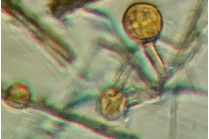 |
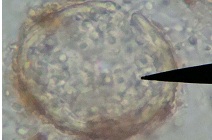 |
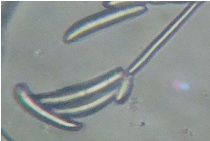 |
Effects of mycorrhizal inoculation on cultivation performance of Camellia plants
Inoculation with ectomycorrhizal fungi significantly increased survival rate, plant height, and flowering rate of tested Camellia plants (Table 1), improved growth performance of Camellia rootstocks (Fig. 2), and stimulated rooting of Camellia cuttings (Fig. 3).
Table 1 Effects of ectomycorrhizal inoculation on growth performance of Camellia plants after three months of planting.
| Treatment | TNCS | SNCS | SR % | MTH (cm) | FR % |
| Non-mycorrhizal | 8000 | 5760 | 72 | 5 | 72 |
| Ectomycorrhizal | 8000 | 7760 | 97 | 9 | 97 |
Notes: TNCS, total number of Camellia seedlings planted at the beginning of the experiment; SNCS, number of Camellia seedlings survived after three months of planting; SR, survival rate; MTH, mean seedlings height; FR, flowering rate
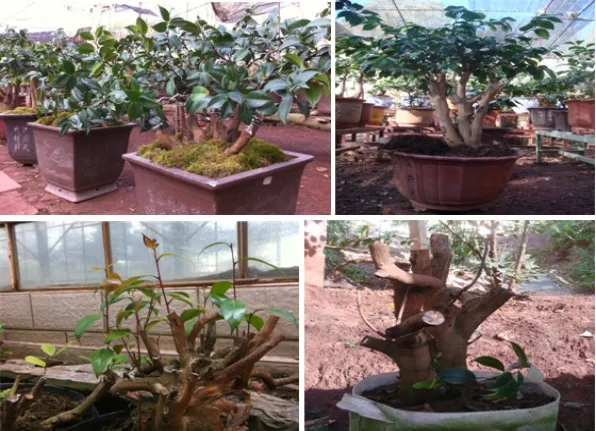
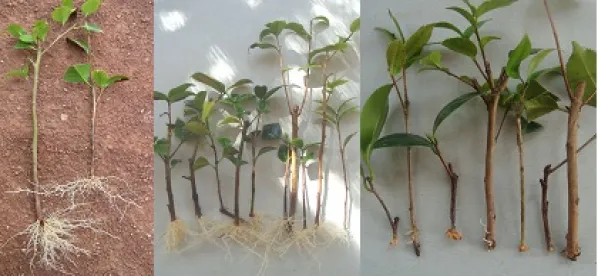
Discussion
The results showed that ectomycorrhizal fungi have a potential in promoting cultivation of Camellia plants. However, because the inocula used in our experiments were mixtures of fungal isolates, it is not possible at this stage to determine which fungal species contribute the most to growth stimulation of the Camellia plants. Further investigation is required to obtain more effective inocula.
According to the existing literature, mycorrhizal fungi are widespread and often in great abundance in the soil of most ecosystems. However, we isolated only 20 fungal species from the Camellia rootlets collected from the field, which is far below the estimated number. Surface sterilization may have killed some mycorrhizal fungi. In addition, the small sample size of the Camellia rootlets used for mycorrhizal fungal isolation accounts for the low diversity. To screen for more growth-promoting mycorrhizal fungal species, a larger sample size and a wider sampling area are required in future research. Molecular techniques will help in revealing the natural mycorrhizal fungal community structures associated with Camellia in the field.
Web design by Tribal Systems
